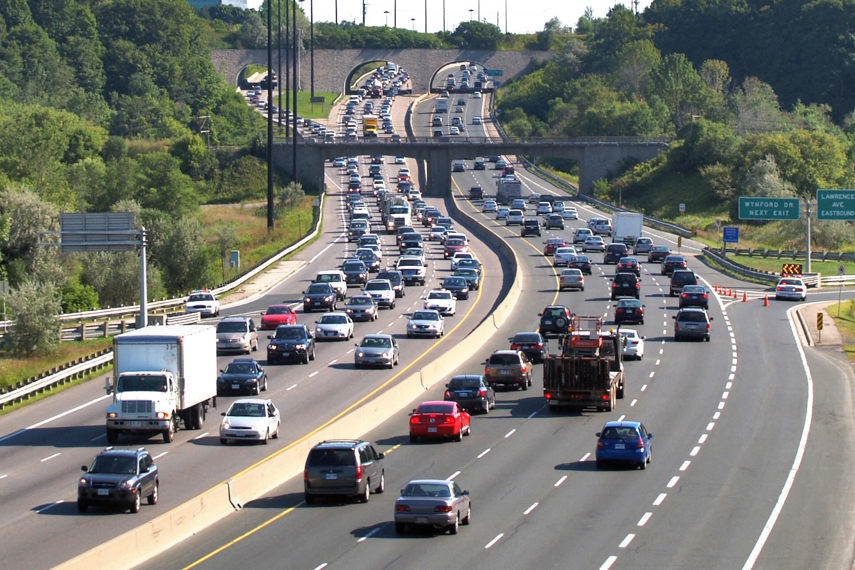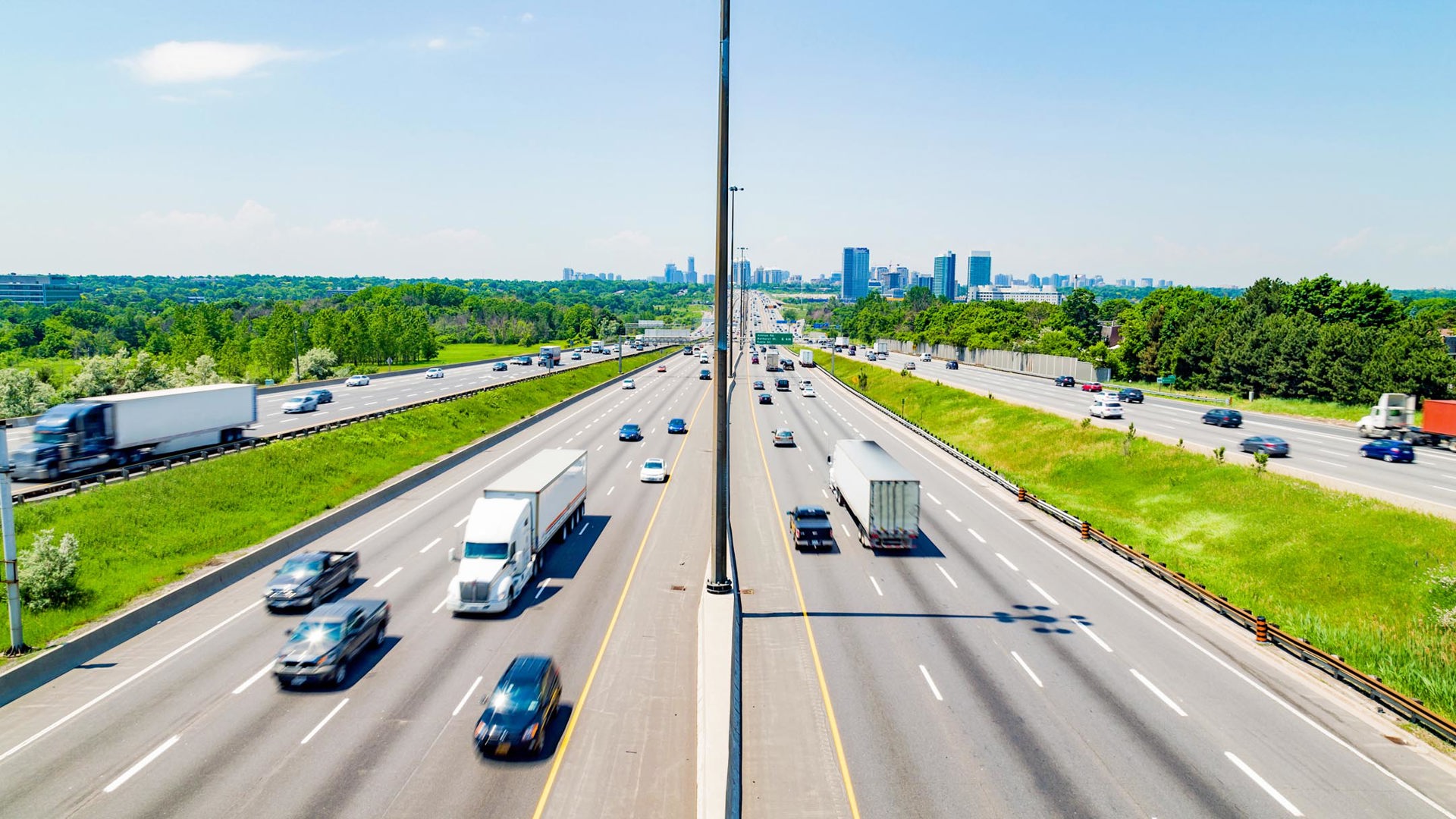Today, Ontario officially raised the speed limit on a few sections of its 400-series highways to 110 km/h from the province’s longstanding 100-km/h limit. The change comes after an 18-month pilot project to gauge public opinion of faster highway speeds and their potential impact on road safety.
The 110 km/h speed limit is now permanent on more than 300 km of the province’s divided highways, including Queen Elizabeth Way from Hamilton to St. Catharines; Highway 401 from Windsor to Tilbury; Highway 402 between London and Sarnia; Highway 404 from Newmarket to Woodbine; and two sections of Highway 417 bracketing the Ottawa area: one from Arnprior to Kanata in the west, and another from Ottawa’s east end to the Quebec border.
This is not the first time Ontario has allowed speeds above 100 km/h on its highways. In the late 1960s, Ontario raised the limit on 400-series roads to 70 mph (113 km/h) for passenger cars, but lowered it to 60 mph (97 km/h) in the 1970s to promote better fuel economy during the oil crisis.
Who supports higher speed limits in Ontario?

As part of its 110-km/h pilot project, the Ontario government surveyed the province’s drivers and found that 80 per cent supported the pilot, and 82 per cent were in favour of raising the speed limit on more sections of 400-series highways.
That poll also showed that 61 per cent of Ontario drivers feel comfortable driving faster than the 100-km/h speed limit, while fewer than 10 per cent feel most comfortable around 100 km/h. Meanwhile, 55 per cent of those surveyed said they did not think drivers would change their speed habits in the 110-km/h zones, while 44 per cent said speeds would increase in the affected areas.
One of the most vocal supporters of higher speed limits in Ontario is an organization called Stop100, which has been lobbying the province since 2012 to raise highway speed limits to 120 km/h “on all metropolitan 400-series highways” and 130 km/h on 400-series roads outside of metropolitan areas.
Stop100 founder Chris Klimek told the Ottawa Citizen he doesn’t think Ontario’s 110 km/h speed limit goes far enough.
“We have state-of-the-art highways,” he said in an interview with the newspaper. “It’s a travesty we’re not letting people use the highways the way they have been intended to be used…. Engineers designed these highways to be perfectly safe to drive at 120.”
Similar public sentiment existed well before Klimek began advocating for faster highway speeds. In 2002, Baher Abdulhai, director of the Toronto Intelligent Transportation Systems Centre and Testbed at U of T, called for a 130-km/h speed limit on Ontario highways. In his view, this would not encourage drivers to go faster, but merely legalize the speeds at which they already travel.
How will the new 110-km/h speed limit affect road safety?

The Ontario government says it “carefully selected” the sections of highway where the new speed limit would apply based on the ability of the infrastructure to accommodate higher speeds. Scott Marshall, Director of Training for the Young Drivers of Canada driving school, says he thinks most of the highways with the new speed limit can handle 110 km/h with no issues, with the exception of some shorter off-ramps, which could catch some people by surprise if they exit at too high a speed.
Ontario is the sixth Canadian province to allow highway driving above 100 km/h: Alberta, B.C., New Brunswick, and Nova Scotia all have a 110 km/h limit on certain highways, while B.C.’s highest legal speed is 120 km/h.
However, many road safety experts are not on board with raising speed limits beyond 100 km/h.
In 2019, a study published in the scientific journal Sustainability showed that the number of fatal collisions in British Columbia went up 20 per cent in the wake of that province’s decision to raise the limit on some of its highways to 120 km/h.
One of the study’s authors, UBC professor Gordon Lovegrove, told the CBC the increase in road deaths wasn’t necessarily the result of the higher speeds, but how drivers react to hazards when travelling more quickly.
“Everybody has heard the phrase ‘speed kills,’” he said in an interview with the CBC. “Well, it’s actually drivers making mistakes that kill themselves and/or their passengers and/or people in other cars. At higher speeds, drivers making mistakes are more catastrophic.”
Also in 2019, the U.S.-based Insurance Institute for Highway Safety (IIHS) published the results of research showing that nearly 37,000 people had died as a result of speed limit increases across the U.S. in the previous 25 years. In 1993, most U.S. states had a 65 mph (105 km/h) speed limit, save for eight jurisdictions in the country’s northeast with a 55-mph limit. But by 2017, most of the country allowed speeds of at least 70 mph (113 km/h), while drivers in several states – mostly in the western half of the country – were permitted to go as fast as 75 and 80 mph (121 and 129 km/h), and even 85 mph (137 km/h) on some roads in Texas.

Five years earlier, Emile Therien, a past president of the Canada Safety Council, effectively predicted those spikes in road deaths in an opinion piece in The Globe and Mail criticizing B.C.’s decision to adopt the 120-km/h limit. Therien said that “the fatality rate of vehicle occupants goes up dramatically” at speeds above 100 km/h, and that those occupants are four times more likely to be killed in a crash at 120 km/h than at 100.
In Ontario’s case, the increased speed limit comes into effect about a month after the OPP revealed that 2021 was the province’s worst year in a decade for road deaths attributed to speeding and/or aggressive driving. According to OPP Sergeant Kerry Schmidt, speeding and aggressive driving were the number-one causes of road fatalities in the province in 2021, with 81 people dying as a result of crashes linked to those two factors. Schmidt also said that speed, inattention, and impairment were the leading causes of the more than 60,000 crashes the OPP responded to last year.
Marshall says he’ll be curious to see whether any further increase in collision rates on the faster sections of highway will be directly linked to increased speeds on those roadways.
“With many people working from home over the past two years now going back to their workplaces, the roads are becoming busy once again,” said Marshall. “With more vehicles on the road, would the collisions on these roads become more severe? A number of other provinces also have 110 km/h limits, so Ontario seems to be following their lead.”
Marshall said the key to staying safe at higher speeds is maintaining an adequate following distance behind other vehicles, and that distance needs to be greater the faster traffic is moving. He thinks driving instructors will have a role to play.
“We should (if not already) be taking our students onto the expressway a number of times, not just once,” said Marshall. “We need to do our part to ensure the novice driver can safely operate the vehicle at those speeds. It could be risky for all those involved if the driver attempts to merge into traffic much slower than the limit.”
Notably, the threshold for Ontario’s stunt driving law will remain 150 km/h on 400-series highways, which could mean licence suspensions and vehicle seizures for drivers going 40 km/h over the new speed limit.
What’s all the worry when Germany has unlimited speeds and 130 km/h is legal in much of Europe?

The German autobahn is a holy grail among driving enthusiasts with its unrestricted speed sections. Here, safety relies on drivers deciding how fast is appropriate for their abilities and those of their vehicles, as well as prevailing traffic and weather conditions.
There are permanent speed limits on about a third of Germany’s highway network, and many of them are dynamic: if the normal limit is 130 km/h, it may drop to 80 km/h in bad weather, for example. Even where there’s no limit, 130 is the “advisory” maximum, though drivers are permitted to go faster if they deem it safe to do so.
Also, Germany’s love for high speeds means its driver licencing process is more difficult and more expensive than it is in Ontario, so we’d argue that drivers there are better prepared for 130 km/h and beyond than many North Americans.
In recent months, the topic of limiting speeds across Germany’s autobahn network has surfaced as part of broader discussions on reducing the country’s dependence on Russian oil and curbing environmental pollution.
A March 2022 article published by TheLocal.de cites claims from Greenpeace and Environmental Action that, by lowering its speed limits, Germany could save 3.7 billion litres of gas and diesel and cut CO2 emissions by 9.2 million tonnes.
And in late 2021, a poll conducted by German broadcaster ARD revealed that 60 per cent of the country’s citizens preferred speed limits over other policies aimed at reducing pollution, like taxing meat and dairy products.
It’s no secret that going faster uses more fuel. According to Natural Resources Canada, most passenger vehicles use about 20 per cent more fuel at 120 km/h than they do at 100. And even if you stick to the new 110-km/h limit, travelling at that speed will make it more difficult to gauge how efficient a new car will be in your normal driving routine. NRCan’s highway driving fuel consumption test for new vehicles assumes an average speed of 78 km/h and a top speed of 97 km/h.
Of course, if you’re in a hurry, going faster will get you to your destination sooner, but not by that much: according to the Ontario Safety League, a 25-km journey takes 15 minutes at 100 km/h, while going 120 km/h would get you there in 12.5 minutes.
Whatever speeds you decide to drive, just consider the potential cost.

